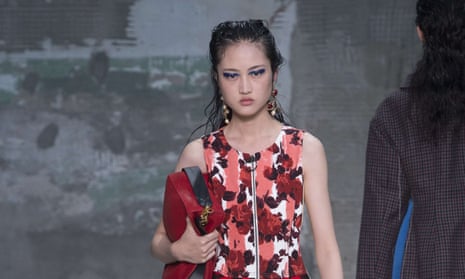Why do models always look so miserable on the catwalk?
Iain, by email
For approximately the 17,321,212nd time, this column finds it can only answer a reader’s question with some assistance from David Sedaris. Don’t we all wish Sedaris had a weekly style column? And restaurant review slot? And celebrity gossip column? And an entire newspaper just to himself? There are not many people who you would eagerly pay money to read on anything, and even fewer who you know would bring greater wisdom to that subject than any of the so-called specialists in their respective fields. But I would pay triple for The Daily Sedaris.
So Iain’s question has reminded me of a throwaway-but-typically-genius line in one of Sedaris’ stories. (Sorry, but I can’t look up which one because if I start going through my Sedaris library then I’ll just start reading and this column will never get finished and, well, deadlines, darlings, deadlines.) Sedaris recalls the ground-shaking moment he realised as a child that the cool kids, who were the sun and moon in his youthful universe, were totally unknown to children in other schools. Those kids had entirely different gods to worship and were completely unaware of the rules of Sedaris’ childish social circles which seemed, to him, as immutable as gravity.
I feel a similar kind of astonishment when someone asks me a question like yours, Iain, one that queries the very foundations upon which fashion is built. As you have rightly noticed, and as some readers may have spotted, too, in the many photos from the fashion shows currently happening, models tend to look pretty miserable on the catwalk. And not just there, but in high-end fashion magazines; with very, very rare exception, models in fashion shoots generally look about as happy as someone who just found out that their new flatmate is Nigel Farage. Looking miserable is the facial expression equivalent of extreme thinness, in the sense that the more miserable and more thin the model, the more elite the fashion show or magazine. So, whereas in catalogues, models tend to look as cheerful and curvaceous as Holly Willoughby, in snootier publications the models have the bodyshape of prisoners of war and the traumatised expressions to match. And it is the same at the shows: in sweet little London fashion week shows, which often have the kind of budget that will probably barely buy you a Dairy Milk post Brexit, the models look healthy and relaxed. But then you go to Milan and Paris, where the fancier shows take place, and the models seem to fade away as the weeks go past, with only their scowls left behind, like the Cheshire cat but scowlier (and less stripey). I went to a Saint Laurent show years ago and Saint Laurent is a label I love, but I remember nothing of the clothes. Instead, I watched in increasing fascination as the models, each one seemingly crosser than the previous, stomped furiously up and down the runway, as though someone had promised them there would be cake and they had lied, again.
So why is it like this? Well, as this column has discussed before, the fashion industry has the mentality of the cool kids in high school or, to be more precise, the cool kids in a 80s movie about an American high school. This means that smoking is still considered cool and looking anything other than terrifying is seen as a bit lame. Hence, while photos of Kate Moss off duty generally show her laughing and looking like great fun, in fashion magazines she is giving the camera a furious death stare. And rather like young Sedaris’s belief about the importance of the popular kids in his school, it is taken for granted by fashion people that this rule is universally known and respected.
Now, we could talk all day about an industry that is ostensibly for women but suggests that the most aspirational look for them is to look half-starved and miserable. And in fact, let’s do just that! I don’t have any other plans – do you? (Aside from re-reading David Sedaris, of course.) So mega fashion conglomerate LVMH recently announced it is “banning” size 0 models, which is one of those statements that might mean something if only size 0 meant something, which it does not. There are no standardised measurements specifying what any size actually denotes, including size 0. Also, given that most models are incredibly tall, they require bigger sizes so that the clothes are long enough to cover their attenuated limbs, so almost none of them are size 0 anyway, no matter how skinny.
In any event, no label, and certainly not the high-end ones within the LVMH family, including Christian Dior, Céline and Marc Jacobs, is going to stop using skinny models, and LVMH knows this. Statements like this are little more than – and I really hate this term – virtue signalling. LVMH knows it will make them look good to say stuff like this, but nothing will change. Have models become noticeably bigger since politicians started making their periodic statements about “taking steps” against “skinny models”? I will kindly answer my own question: no, they have not. But those statements sure sound nice, don’t they?
So, Iain, you ask me why models look so miserable? I shall tell you. They look miserable because they are sick of being disparaged by people – the media, their bosses, clueless politicians – in the name of looking woke, while simultaneously being obliged to keep their body mass index under 19 so that people don’t think they are stuck in the Littlewoods catalogue these days. Because that is how screwed up the fashion industry and the social expectations reflected by the industry now are. That would nark you off a bit, too, wouldn’t it?

Comments (…)
Sign in or create your Guardian account to join the discussion